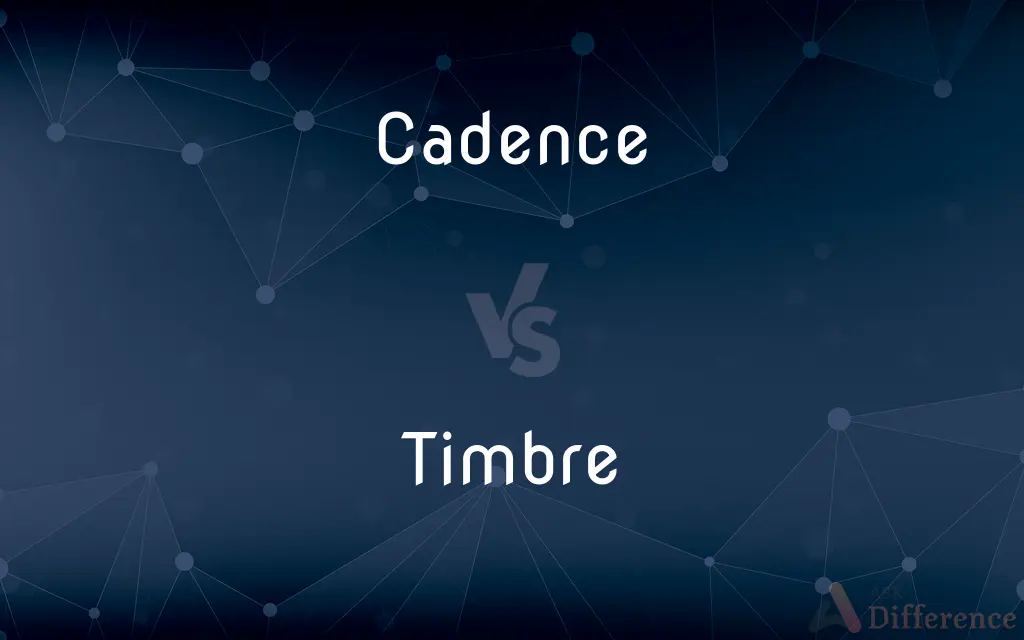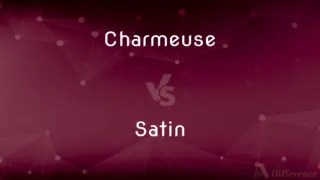Cadence vs. Timbre — What's the Difference?
By Tayyaba Rehman — Updated on November 1, 2023
Cadence is the rhythmic flow of sounds in language or music, while timbre is the unique quality of sound that distinguishes one voice or instrument from another.

Difference Between Cadence and Timbre
Table of Contents
ADVERTISEMENT
Key Differences
Cadence in music refers to the sequence of notes or chords that signifies the conclusion of a passage or piece. It's the rhythm, the rise and fall within a phrase, whether it's in speech or music. Timbre, however, is distinct as it refers to the tone quality or color of a sound. It's what makes a note played on a piano sound different from the same note played on a violin. Cadence is about pacing and progression, whereas timbre is about the texture and quality of sound.
When a speaker uses cadence, they are controlling the tempo and rhythm of their speech to convey a particular mood or to enhance the flow of words. Timbre in a speaker's voice would refer to the unique quality that makes their voice recognizable and distinct from others, like the grainy voice of a blues singer compared to the clear, ringing voice of an opera singer. Both cadence and timbre contribute to the overall auditory experience but in different ways.
Cadence is also present in poetry, where it can affect the flow and emotional response of the poem through meter and word placement. Timbre is not a poetic device but a sonic one; thus, it doesn't apply to poetry unless the poem is read aloud, in which case the reader's unique voice timbre will affect the listener's experience.
In a broader sense, cadence can apply to the flow of events or movements within a certain domain, such as the cadence of a dance routine. Timbre would not apply in this context, as it is specific to auditory experiences and refers to the characteristic sound of an instrument or voice.
Comparison Chart
Definition
Rhythmic flow of a sequence of sounds.
Unique quality of sound distinguishing sources.
ADVERTISEMENT
Component of
Rhythm and pace in music and language.
Sound quality or color in music and voices.
Role in Music
Indicates the end of a phrase or piece.
Distinguishes different instruments or voices.
Perception
Felt in the rhythm and tempo.
Heard in the quality and texture of sound.
Relation to Sound
Pertains to timing and progression.
Pertains to the character of the sound.
Compare with Definitions
Cadence
The rhythmic sequence or flow of sounds in language.
The cadence of her speech captivated the audience.
Timbre
The quality of a sound that distinguishes it from others.
The violin’s timbre set it apart from the cello.
Cadence
The concluding part of a musical phrase.
The song ended with a gentle cadence.
Timbre
The texture of sound that makes it unique.
The timbre of the ancient woodwind was haunting.
Cadence
In Western musical theory, a cadence (Latin cadentia, "a falling") is the end of a phrase in which the melody or harmony creates a sense of resolution. A harmonic cadence is a progression of two or more chords that concludes a phrase, section, or piece of music.
Timbre
The resonance by which the ear recognizes and differentiates sound.
Even in the chorus, his voice’s timbre was unmistakable.
Cadence
A modulation or inflection of the voice
The measured cadences that he employed in the Senate
Timbre
The tonal color or quality of sound.
The timbre of the saxophone filled the jazz club.
Cadence
A sequence of notes or chords comprising the close of a musical phrase
The final cadences of the Prelude
Timbre
In music, timbre ( TAM-bər, TIM-), also known as tone color or tone quality (from psychoacoustics), is the perceived sound quality of a musical note, sound or tone. Timbre distinguishes different types of sound production, such as choir voices and musical instruments.
Cadence
Balanced, rhythmic flow, as of poetry or oratory.
Timbre
The combination of qualities of a sound that distinguishes it from other sounds of the same pitch and volume.
Cadence
The measure or beat of movement, as in dancing or marching.
Timbre
Distinctive character
The timbre of the painter's work.
Cadence
A rhythmic chant, often in call-and-response form, used by soldiers to keep in step when marching or running.
Timbre
The quality of a sound independent of its pitch and volume.
Cadence
A falling inflection of the voice, as at the end of a sentence.
Timbre
The pitch of a sound as heard by the ear, described relative to its absolute pitch.
When someone speaks after inhaling helium, his voice has a higher timbre. With sulfur hexafluoride, the result is a lower timbre.
Cadence
General inflection or modulation of the voice.
Timbre
(heraldry) The crest on a coat of arms.
Cadence
(Music) A progression of chords moving to a harmonic close, point of rest, or sense of resolution.
Timbre
See 1st Timber.
Cadence
The act or state of declining or sinking.
Timbre
The crest on a coat of arms.
Cadence
Balanced, rhythmic flow.
Timbre
The quality or tone distinguishing voices or instruments; tone color; clang tint; as, the timbre of the voice; the timbre of a violin. See Tone, and Partial tones, under Partial.
Cadence
The measure or beat of movement.
Timbre
(music) the distinctive property of a complex sound (a voice or noise or musical sound);
The timbre of her soprano was rich and lovely
The muffled tones of the broken bell summoned them to meet
Cadence
The general inflection or modulation of the voice, or of any sound.
Timbre
The characteristic tone of a musical instrument or voice.
Her voice had a rich, warm timbre.
Cadence
(music) A progression of at least two chords which conclude a piece of music, section or musical phrases within it. Sometimes referred to analogously as musical punctuation.
Cadence
(music) A cadenza, or closing embellishment; a pause before the end of a strain, which the performer may fill with a flight of fancy.
Cadence
(speech) A fall in inflection of a speaker’s voice, such as at the end of a sentence.
Cadence
(dance) A dance move which ends a phrase.
The cadence in a galliard step refers to the final leap in a cinquepace sequence.
Cadence
(fencing) The rhythm and sequence of a series of actions.
Cadence
(running) The number of steps per minute.
Cadence
(cycling) The number of revolutions per minute of the cranks or pedals of a bicycle.
Cadence
(military) A chant that is sung by military personnel while running or marching; a jody call.
Cadence
(heraldry) cadency
Cadence
(horse-riding) Harmony and proportion of movement, as in a well-managed horse.
Cadence
(horseracing) The number of strides per second of a racehorse, measured when the same foot/hoof strikes the ground
Cadence
(software development) The frequency of regular product releases.
Cadence
To give a cadence to.
Cadence
To give structure to.
Cadence
The act or state of declining or sinking.
Now was the sun in western cadence low.
Cadence
A fall of the voice in reading or speaking, especially at the end of a sentence.
Cadence
A rhythmical modulation of the voice or of any sound; as, music of bells in cadence sweet.
Blustering winds, which all night longHad roused the sea, now with hoarse cadence lullSeafaring men o'erwatched.
The accents . . . were in passion's tenderest cadence.
Cadence
Rhythmical flow of language, in prose or verse.
Golden cadence of poesy.
If in any composition much attention was paid to the flow of the rhythm, it was said (at least in the 14th and 15th centuries) to be "prosed in faire cadence."
Cadence
See Cadency.
Cadence
Harmony and proportion in motions, as of a well-managed horse.
Cadence
A uniform time and place in marching.
Cadence
The close or fall of a strain; the point of rest, commonly reached by the immediate succession of the tonic to the dominant chord.
Cadence
To regulate by musical measure.
These parting numbers, cadenced by my grief.
Cadence
(prosody) the accent in a metrical foot of verse
Cadence
The close of a musical section
Cadence
A recurrent rhythmical series
Cadence
The measured movement in dancing or marching.
The soldiers moved with a precise cadence.
Cadence
The modulation of the voice.
He spoke with a cadence that soothed the listeners.
Cadence
The pace at which something progresses.
The project continued at a steady cadence.
Common Curiosities
What is cadence in poetry?
It's the rhythmic pacing or flow of the poem.
Can two instruments have the same timbre?
No, timbre is unique to each instrument or voice.
How does one identify cadence in speech?
Through the rise and fall of the speaker's rhythm and pace.
Does timbre affect a song’s genre?
It can influence it, as certain timbres are characteristic of specific genres.
Is cadence important in music?
Yes, it helps structure the piece and gives resolution.
Can cadence be slow?
Yes, cadence can be any tempo, dictating the pace.
Is timbre related to pitch?
No, it's independent of pitch; it's about sound quality.
Can cadence be found in literature?
Yes, through the pacing and flow of the writing.
What affects an instrument's timbre?
Its material, shape, and the way it’s played.
Do conductors influence cadence?
Yes, they direct the pace and flow of the music.
Are cadence and rhythm the same?
Not exactly; cadence is part of rhythm but focuses on the end of phrases.
Does everyone have a unique voice timbre?
Yes, each person’s voice has a distinctive sound.
Is timbre important in identifying a speaker?
Yes, it helps in recognizing who is speaking.
Can timbre change over time?
Yes, changes in an instrument or voice can alter its timbre.
Are cadence and meter related?
Yes, meter can influence the cadence in poetry and music.
Share Your Discovery

Previous Comparison
Charmeuse vs. Satin
Next Comparison
Bawling vs. CryingAuthor Spotlight
Written by
Tayyaba RehmanTayyaba Rehman is a distinguished writer, currently serving as a primary contributor to askdifference.com. As a researcher in semantics and etymology, Tayyaba's passion for the complexity of languages and their distinctions has found a perfect home on the platform. Tayyaba delves into the intricacies of language, distinguishing between commonly confused words and phrases, thereby providing clarity for readers worldwide.














































